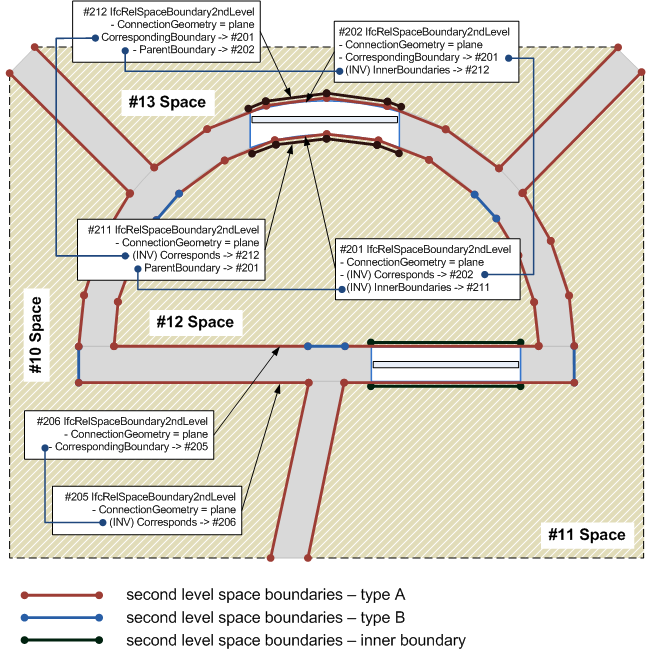5.4.3.61 IfcRelSpaceBoundary2ndLevel
5.4.3.61.1 Semantic definition
The 2nd level space boundary defines the physical or virtual delimiter of a space by the relationship IfcRelSpaceBoundary2ndLevel to the surrounding elements. 2nd level space boundaries are characterized by:
- 2nd level space boundaries still represent building elements that bound the space, but are more granular in that they are subdivided in any of the following cases:
- Differences in materials and/or material assemblies (for example, a wainscot or paneling on the lower portion of a wall).
- Differences in spaces or zones on the other side of the building element (or virtual boundary) represented by the space boundary (for example, two different spaces on the other side of a wall)
- 2nd level space boundaries are differentiated in two ways: virtual or physical and internal or external, whereby any space boundary that is both internal and external has to be split into segments being either internal or external.
- 2nd level space boundaries represent both sides of a heat transfer surface separated by the thickness of the building element. They can be further differentiated in:
- Type 2a that occurs when there is a space on the opposite side of the building element providing the space boundary
- Type 2b occurs if there is a building element on the opposite side of the building element providing the space boundary.
- The connection geometry of 2nd level space boundaries is restricted to planar surfaces only. This means that curved surfaces must be segmented.
2nd level space boundaries define the heat transfer surfaces on both sides of building elements that separate spaces. The generation of 2nd level space boundaries has to take building elements and spaces on the other side into account.
Relationship Use Definitions
As shown in Figure 5.4.3.61.A, the attribute ParentBoundary with inverse InnerBoundaries is provided to link the space boundaries of doors, windows, and openings to the parent boundary, such as of a wall or slab.
The attribute CorrespondingBoundary with inverse Corresponds is provided to link the pair of space boundaries on the opposite sides of the building element.

Geometry Use Definitions
See the definition at the supertype IfcRelSpaceBoundary for guidance on using the connection geometry for second level space boundaries.
5.4.3.61.2 Entity inheritance
-
- IfcRelSpaceBoundary
- IfcRelConnectsElements
- IfcRelConnectsPortToElement
- IfcRelConnectsPorts
- IfcRelConnectsStructuralActivity
- IfcRelConnectsStructuralMember
- IfcRelContainedInSpatialStructure
- IfcRelCoversBldgElements
- IfcRelCoversSpaces
- IfcRelFillsElement
- IfcRelFlowControlElements
- IfcRelInterferesElements
- IfcRelPositions
- IfcRelReferencedInSpatialStructure
- IfcRelSequence
- IfcRelServicesBuildings
5.4.3.61.3 Attributes
| # | Attribute | Type | Description |
|---|---|---|---|
| IfcRoot (4) | |||
| 1 | GlobalId | IfcGloballyUniqueId |
Assignment of a globally unique identifier within the entire software world. |
| 2 | OwnerHistory | OPTIONAL IfcOwnerHistory |
Assignment of the information about the current ownership of that object, including owning actor, application, local identification and information captured about the recent changes of the object. |
| 3 | Name | OPTIONAL IfcLabel |
An optional name for use by the participating software systems or users. For some subtypes of IfcRoot the insertion of the Name attribute may be required. This would be enforced by a where rule. |
| 4 | Description | OPTIONAL IfcText |
An optional description, provided to exchange informative comments. |
| IfcRelSpaceBoundary (5) | |||
| 5 | RelatingSpace | IfcSpaceBoundarySelect |
Reference to one space that is delimited by this boundary. |
| 6 | RelatedBuildingElement | IfcElement |
Reference to the Element that defines the Space Boundaries. |
| 7 | ConnectionGeometry | OPTIONAL IfcConnectionGeometry |
Physical representation of the space boundary. Provided as a curve or surface given within the LCS of the space. |
| 8 | PhysicalOrVirtualBoundary | IfcPhysicalOrVirtualEnum |
Defines whether the Space Boundary is PHYISICAL or VIRTUAL. |
| 9 | InternalOrExternalBoundary | IfcInternalOrExternalEnum |
Defines whether the Space Boundary is INTERNAL, or EXTERNAL, i.e. adjacent to open space that can be a partially enclosed space, such as terrace. |
| IfcRelSpaceBoundary1stLevel (2) | |||
| 10 | ParentBoundary | OPTIONAL IfcRelSpaceBoundary1stLevel |
Reference to the host, or parent, space boundary within which this inner boundary is defined. |
| InnerBoundaries | SET [0:?] OF IfcRelSpaceBoundary1stLevel FOR ParentBoundary |
Reference to the inner boundaries of the space boundary. Inner boundaries are defined by the space boundaries of openings, doors and windows. |
|
| Click to show 11 hidden inherited attributes Click to hide 11 inherited attributes | |||
| IfcRelSpaceBoundary2ndLevel (2) | |||
| 11 | CorrespondingBoundary | OPTIONAL IfcRelSpaceBoundary2ndLevel |
Reference to the other space boundary of the pair of two space boundaries on either side of a space separating thermal boundary element. |
| Corresponds | SET [0:1] OF IfcRelSpaceBoundary2ndLevel FOR CorrespondingBoundary |
Reference to the other space boundary of the pair of two space boundaries on either side of a space separating thermal boundary element. |
|
5.4.3.61.4 Concept usage
| Concept | Usage | Description | |
|---|---|---|---|
| IfcRoot (2) | |||
| Revision Control | General |
Ownership, history, and merge state is captured using IfcOwnerHistory. |
|
| Software Identity | General |
IfcRoot assigns the globally unique ID. In addition, it may also provide a name and description for the concept. |
|
| Click to show 2 hidden inherited concepts Click to hide 2 inherited concepts | |||
5.4.3.61.5 Formal representation
ENTITY IfcRelSpaceBoundary2ndLevel
SUBTYPE OF (IfcRelSpaceBoundary1stLevel);
CorrespondingBoundary : OPTIONAL IfcRelSpaceBoundary2ndLevel;
INVERSE
Corresponds : SET [0:1] OF IfcRelSpaceBoundary2ndLevel FOR CorrespondingBoundary;
END_ENTITY;